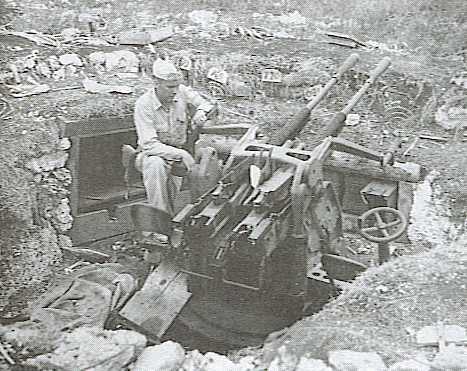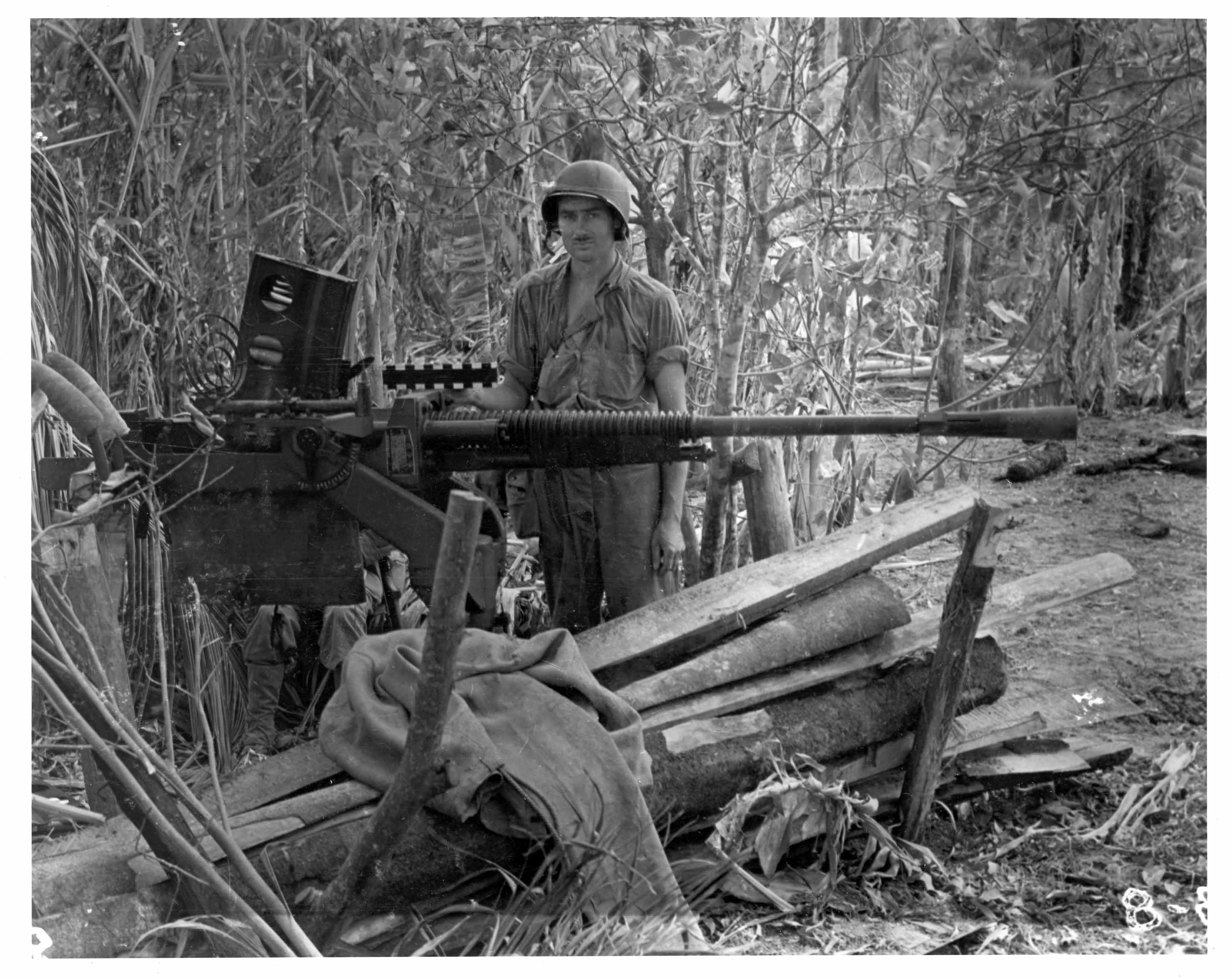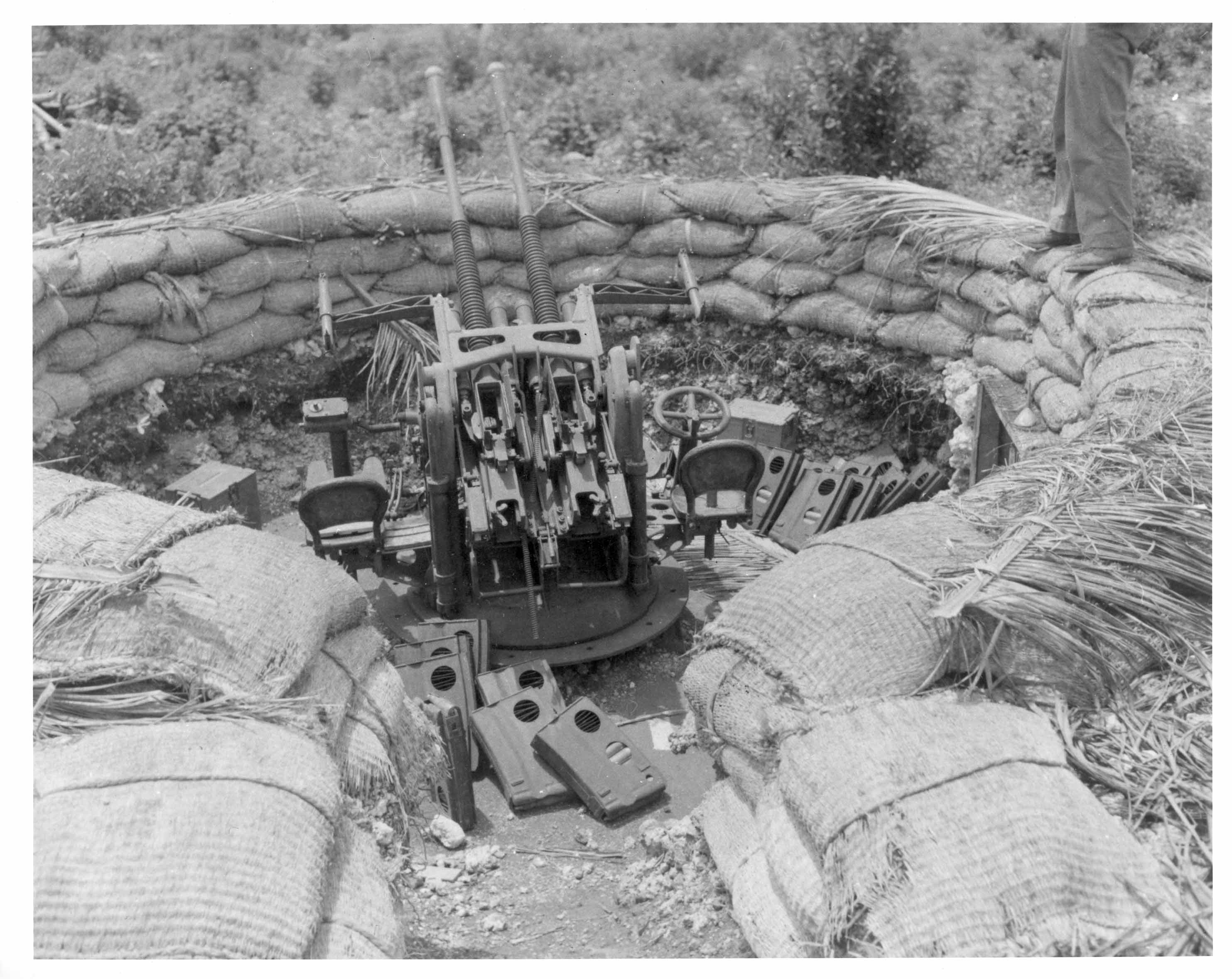In 1935 the Japanese decided to replace the Vickers 4 cm/62 "HI" (aka "BI") (2-pdr) guns because of their slow rate of fire, short effective range, unreliable nature and difficulty of manufacture. A design based upon the French Hotchkiss machine gun was selected as the replacement. French built twin mounts, designated as 25 mm Type 94 and Type 95, were tested at the Yokosuka Navy Yard in 1935. French built guns were known as "Type J" as they were built to Japanese specifications. The Japanese manufactured version was adopted for service use on 6 August 1936. Japanese modifications included many stainless steel parts for use on submarines, the replacement of some machined parts by castings and the use of Rheinmetall-type flash suppressors. Originally issued in twin mountings, triple mounts were introduced in 1941 and single mounts in 1943.
The 25 mm Type 96 was widely used throughout the Japanese Navy with a total of about 33,000 guns being manufactured. By the start of 1945, Japan was producing at a monthly rate of 2,100 single and about 200 dual or triple mountings. Most of these guns were mounted on ships, but about 2,500 were used in stationary land mountings.
The Japanese considered the 25 mm gun to be an excellent weapon, but it did not compare well to either the Bofors 40 mm or to the Oerlikon 20 mm weapons used by the Allies.
The magazines for the Type 96 held only 15 rounds, so frequent stoppages for change outs were required. By 1945, these weapons fired projectiles too light and too short ranged to effectively engage the heavier and faster US aircraft then in service.
The Japanese were the only major navy of World War II not to develop and deploy any AA machine guns larger than 25 mm (1").
This weapon had a forged monobloc barrel and the automatics were gas-operated. Chrome plating of the bore was investigated, but the results were not exceptional and development was abandoned.
| Designation | 25 mm/60 (1") Type 96 (Model 1936)
Official Designation: 96 Type 25 mm Machine Gun Type 94 and Type 95 were French built prototypes known as "Type J" |
|---|---|
| Ship Class Used On | Almost all warships of World War II |
| Date Of Design | 1935 (In Japan) |
| Date In Service | 1936 |
| Gun Weight | 253.5 lbs. (115 kg) not including magazine |
| Gun Length oa | 90.4 in. (2.296 m)1 |
| Barrel Length | 59.1 in (1.500 m) |
| Rifling Length | 53.2 in. (1.350 m) |
| Grooves | (12) 0.0098 in deep x 0.141 in (0.25 mm x 3.58 mm) |
| Lands | 0.117 in (2.96 mm) |
| Twist | Uniform 1 in 25.2 |
| Chamber Volume | N/A |
| Rate Of Fire 2 | Cyclic: 200 - 260 rounds per minute, 220 standard 3 Effective: 110 - 120 rounds per minute |
- ^One source gives a gun length of 96.5 in (2.420 m).
- ^Cartridge ejection was a problem at high elevations and stoppages were frequent.
- ^Cyclic rate was controlled by changing the gas control valve setting with the standard rate being the fourth setting. The gun could also be fired in single shots.
- The barrel was secured to the breech mechanism by screw threads, but the gas cylinder connections made changeouts difficult. Two men using a hammer and a spanner wrench could complete a changeout in about five minutes.
- The firing pin was a source of trouble, as the original design had a life of only 250 rounds before breaking. This was corrected by improving the heat treatment, the shape and the machining of the pin. The tip of the pin was changed from a long, thin point to a nearly conical point. These changes improved the life to about 4,000 rounds.
- The bolt was locked to the rear when the magazine emptied. Changeout to a fresh magazine allowed the trigger to unlock the bolt. When the locking mechanism was worn, inserting a fresh magazine could cause the gun to fire unintentionally.
| Type | Fixed |
|---|---|
| Weight of Complete Round | All types about 1.5 lbs. (0.68 kg) |
| Projectile Types and Weights 1a 2a | AP: 0.57 lbs. (0.26 kg)
Common: 0.55 lbs. (0.24 kg) Incendiary Common: 0.55 lbs. (0.25 kg) Tracer: 0.55 lbs. (0.25 kg) |
| Bursting Charge | AP and Tracer: None
Common: 0.02 lbs. (0.01 kg) Incendiary Common: 0.02 lbs. (0.01 kg) |
| Projectile Length | AP: 4.0 in (10.2 cm)
Common: 4.4 in (11.2 cm) Incendiary Common: 4.3 in (11.0 cm) |
| Propellant Charge | 3.60 - 3.88 oz. (102 - 110 gm) Type 1 No. 2 (K3) |
| Muzzle Velocity | 2,953 fps (900 mps) |
| Working Pressure | 17.1 tons/in2 (2,700 kg/cm2) |
| Approximate Barrel Life | 12,000 rounds 3a |
| Ammunition stowage per gun | 2,000 rounds 4a |
- ^A Note on Sources: Projectile data taken from "Japanese Cruisers of the Pacific War." "Naval Weapons of World War Two" says that the AP round weighed 0.62 lbs. (0.28 kg).
- ^
Shell Colors AP White Common Maroon Incendiary Common Orange Tracer Yellow - ^The original French estimate for barrel life was about 6,000 rounds but the Japanese found in testing that stable flight was still obtained after 20,000 rounds. Muzzle velocity loss during this test was found to be 150 mps (492 fps) after 16,000 rounds and 220 mps 710 fps) after 23,000 rounds. The above figure is for 100 mps (328 fps) which the Japanese considered to be the maximum acceptable loss for fire control purposes.
- ^Normal allocation was one tracer in every five rounds.
| Elevation | Distance |
|---|---|
| 45 degrees | 7,439 yards (6,800 m) |
| 50 degrees | 8,200 yards (7,500 m) |
| AA Ceiling @ 85 degrees | Effective: 9,843 feet (3,000 m)
Maximum: 18,040 feet (5,500 m) |
The sources listed below disagree as to the ranges and AA ceiling for this weapon. I have chosen to use those given in "Japanese Cruisers of the Pacific War."
| Designation 1b 2b 3b | Surface Ships and Land
Single: Type 96 Models 1, 3 and 10 4b Twin: Type 96 Models 1 and 2 5b Triple Mounts: Type 96 Models 1 and 2 6b Submarines 7b |
|---|---|
| Weight | Single: 1,731 lbs. (785 kg)
Twin: 2,425 lbs. (1,100 kg) Triple: 3,970 lbs. (1,800 kg) |
| Elevation | -10 / +85 degrees |
| Elevation Rate | Most were manually operated
Some triples had Ward-Leonard RPC: 12 degrees per second 8b |
| Train | 360 degrees |
| Train Rate | Most were manually operated
Some triples had Ward-Leonard RPC: 18 degrees per second 8b |
| Gun recoil | 4.33 in (11 cm) |
- ^About 20,000 mountings of all types were produced.
- ^
Ship board installations according to O-47(N)-2 Ship Triples Twins Singles Yamato class 40 - 30 Nagato class 30 - 30 Ise, Fuso and Kongô classes 20 6 30 Shokaku class 20 - 30 Small carriers 40 - 30 First class (Heavy) cruisers 18 - 16 Second class (Light) cruisers 12 - 10 Destroyers 4 4 10 - ^
According to US Naval Technical Mission to Japan report O-47(N)-2, the Japanese saw the following deficiencies in these mountings in decreasing order of seriousness:
- The multiple mounts could not be trained and elevated rapidly enough, either by power or manual drive.
- The gunsights were inadequate against high speed aircraft.
- The guns had excessive vibration, making them difficult to keep on target.
- The capacity of the ammunition supply equipment was inadequate, causing interrupted fire and a greatly reduced operating routine.
- The muzzle blast caused problems for both the guncrew and equipment.
- ^Single Models 1 and 3 were free swinging, Model 10 was for torpedo boats and traverse was by body inside ring with elevation by handwheel.
- ^Twin Models 1 and 2 were trained and elevated by geared handwheels.
- ^Triple Models 1 and 2 were trained and elevated by geared handwheels.
- ^Submarine mounts were generally similar to the surface ship mounts and had many stainless steel parts to resist corrosion. Single Mount Model 1 could be lowered manually into the hull. Single Mount Model 4 Mod 1 could not be lowered. Single Mount Model 4 Mod 2 could be lowered by remote control. None of the twin or triple mountings could be lowered.
- Besides the Models listed above, there were also mobile single land mountings Models 6 and 8 which were on two-wheel carriages. Twin mountings were also mounted on trucks. A total of about 100 guns were used in these single and twin mobile mountings.
- Manually controlled Triple mountings had nine crewmembers (1 pointer, 1 trainer, 1 sight setter and 2 loaders per gun). Twin mountings were similarly manned (seven crewmembers total). Single mountings had three crewmembers (1 gun layer, 1 loader and 1 gun captain).
- Apparently, all magazines had to be loaded by hand as no specialized loading equipment was ever developed.
- All guns were air-cooled. Water-cooling had been investigated, but rejected due to increased complexity and maintenance requirements. Guncrews would sometimes wrap wet cloths around the barrels as a cooling method.
- Most mountings did not have shields. An exception was the mountings on the Yamato class which were given Ducol steel shields to protect against blast.



Naval Weapons of World War Two" by John Campbell
"Battleships: Axis and Neutral Battleships in World War II" by W.H. Garzke, Jr. and R.O. Dulin, Jr.
"Japanese Cruisers of the Pacific War" by Eric Lacroix and Linton Wells II
"Anatomy of the Ship: The Heavy Cruiser Takao" and "Anatomy of the Ship: The Battleship Yamato" both by Janusz Skulksi
"Cruisers of World War Two" by M.J. Whitley
"Rapid Fire" by Anthony G. Williams
---
US Naval Technical Mission to Japan report O-47(N)-2: Japanese Naval Guns and Mounts-Article 2, AA Machine Guns and Mounts
---
Special help from Nathan Okun
Ichinohe Takao 25 mm page
3 December 2008 - Benchmark
04 March 2009 - Redid picture of twin gun on Guam
20 January 2014 - Reset Ichinohe Takao link to Archives
12 July 2015 - Minor changes
07 January 2021 - Reorganized notes, converted to HTML 5 format, added data about guns and mountings
20 March 2021 - Corrected introduction dates of single and triple mountings
17 November 2021 - Added manufacturing rate, barrel wear and empty magazine information

